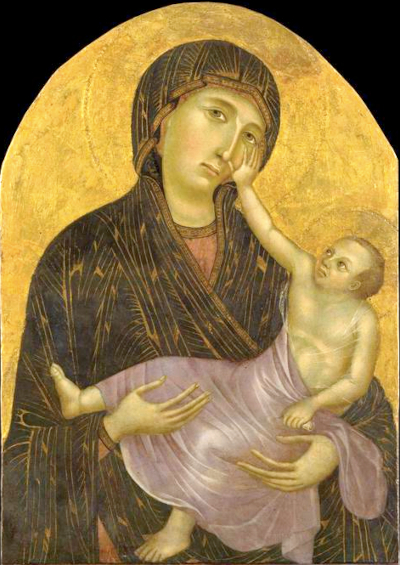The Castelfiorentino Madonna hangs in the Museo di Santa Verdiana in Castelfiorentino and is loosely attributed to Cimabue.
Introduction
Whilst the painting's attribution has been discussed and debated at length over the years, the majority opinion seems to back Cimabue as being its creator. Many had previously connected it to Duccio, or suggested perhaps a collaboration between the two.
Restoration projects across the 20th century have poured more light on the piece and enabled us to learn more about its origins. This has led to firmer claims being made in the direction of Cimabue. It appears unlikely that this mystery will ever be entirely solved, and the best we can hope for is a general concensus based around each artist's other works.
Description
This Madonna features mother and child in a relatively simple double portrait. The baby looks up towards its mother, with an arm outstretched. The Madonna however looks directly towards the viewer, with her head slightly tilted to one side. She is dressed in a modest blue cloak which is patterned in orange.
She holds her hands open to hold her newborn child, who himself is wrapped in a pink cloth. The mother has an orange under garment, with embroidered trim around her neckline. She holds a serious expression, as typical for Cimabue. The child, by contrast, appears more playful in its demeanor.
Cimabue fills the background with a flat tone of gold leaf paint, bringing a majestic finish to the work, but avoids adding any form of detail. Perhaps, therefore, this was intended as a devotional piece, for the intended buyer. The painting is dated to the late 13th century, and it would be some years yet before more expressive portraits would appear.
Painting Details
The piece is 68 x 47 cm, making it an ideal size for devotional use, perhaps in a bedroom or other domestic setting. The piece is loosely dated to around the 1280s, and without a clear artist attribution it is impossible to much more accurate than this. Some have suggested that Duccio helped his master out on this piece, as part of his technical development.
Legacy of the Castelfiorentino Madonna
The Castelfiorentino Madonna remains shrouded in mystery, connected to master and apprentice, but without enough clear information to precisely place the piece within their careers. Studios were filled with collaborative projects and the merging and exchanging of artistic styles, making documentation key to solving some of these mysteries.
The sheer amount of time that has passed since, makes any documentation unlikely in the extreme, and leaves us with having to piece different artist's careers together to try to come up with just the merest of theories on this particular piece.
Conclusion
With questions remaining regarding the attribution of this painting, it better serves as an example of the overall period, representing portraiture in late 13th century Italy. The style of facial expressions, detail, the use of golden leaf paint and the sombre expressions are all entirely consistent with the period.
For many, this type of work underlines the contrast between the 13th century and 15th century eras, where advancements were made by the likes of Da Vinci and Raphael, whilst taking on many of the very same themes as used by Giotto, Cimabue and Duccio.




